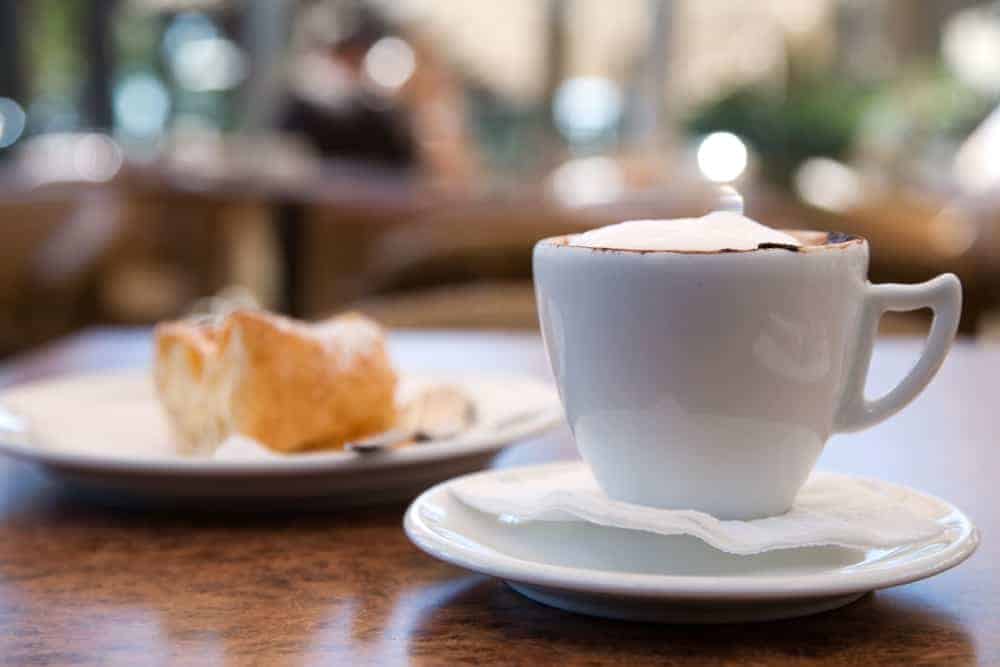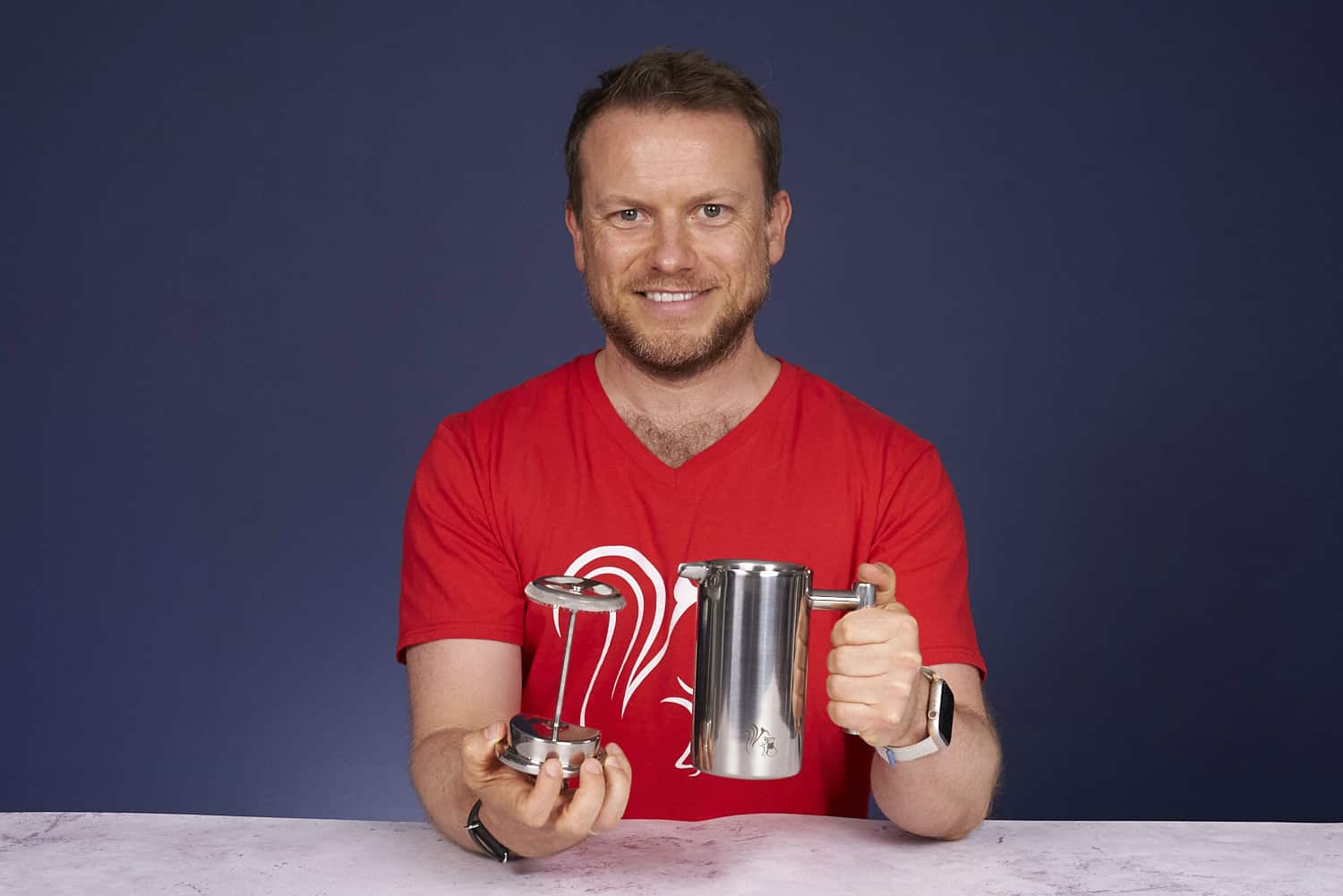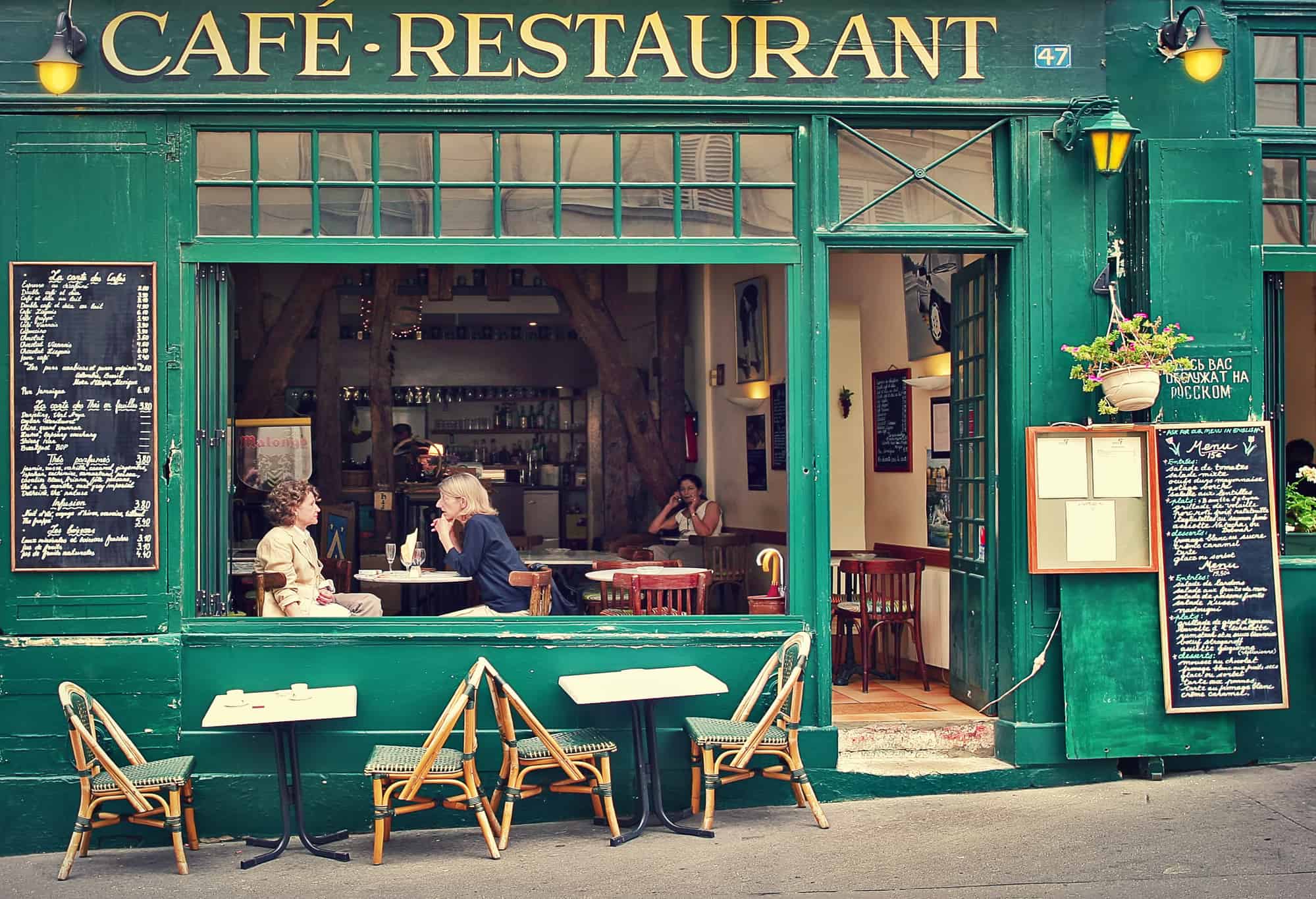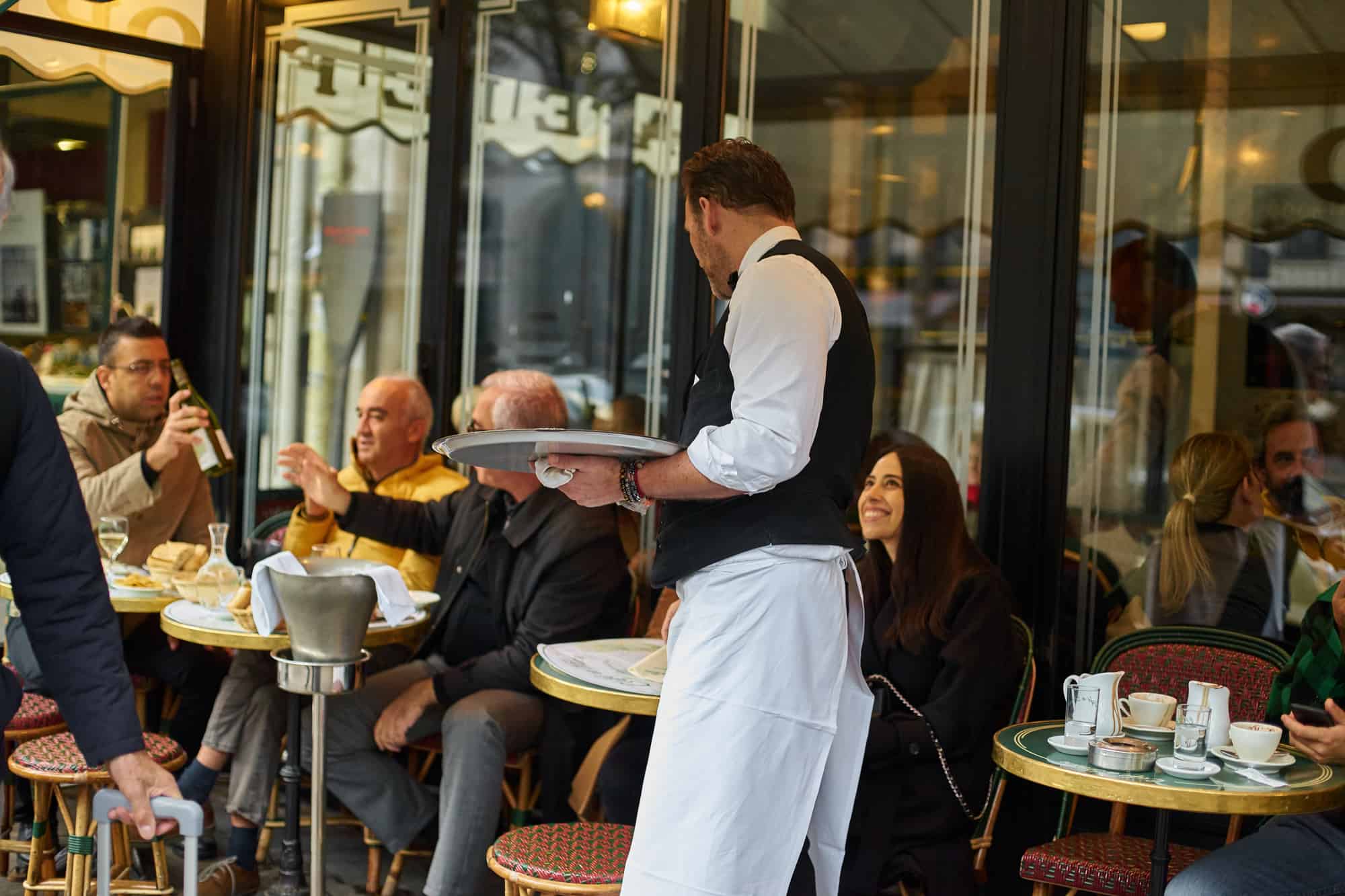French or faux? That is the question – at least in this article, where we explore French coffee and how best to go with the flow of joe when visiting the country.
Much like French fries and French kissing, not everything that we like to call French is necessarily français. Take the French press, for example. Is it the French coffee mainstay or are you being led astray?
Table of Contents
Not So French Press Coffee
Before we rush to answer that question, let’s make sure we’re all on the same page. Wondering what French press coffee?
It’s a manual brewing method in which coffee grounds are fully immersed and steeped for a time in water. When you press the plunger, the grounds are forced to the bottom of the carafe. To avoid over extraction, you should serve it immediately.
Although two Frenchmen invented the earliest version in 1852, the Italians Attilio Calimani and Giulio Moneta patented the plunger we know and love today in 1929.
Following a further tweak by Swiss designer Faliero Bondanini in 1958, the version that became known as the Chambord went into production in France.
Despite that history, you won’t find French press coffee on offer in the country’s many cafés, where the locals prefer espresso. That’s a shame because the French press is a simple and very affordable way to brew delicious coffee.
Here at Coffeeness, we don’t like to disappoint. So, while your vacation in France might be sans cafétiére, we’ve put together a quick rundown on how to use a French press coffee maker for when you’re back home.
You can check out my guide on how to use a French Press. I’ve also written a Bodum French Press Review to help you choose the right press pot for your particular needs.
What Is French Roast Coffee? A Shot of the Dark
Another candidate for our French or faux test is the French roast profile. The first thing to understand is that French is a roasting style. In other words, any beans can be French roasted but expect them to be très, très dark – darker, in fact than a conventional espresso roast.
This style took off in the 19th century when Europeans favored beans roasted at high temperatures. Back then, Robusta, which is generally roasted darker, dominated the French market.
Why? In a word, economics. Robusta was produced at lower cost than Arabica in France’s West African colonies and imported duty free. And the fact that Robusta also delivered a big buzz to the many men in frilly shirts – women weren’t welcome – in the coffee houses of the time certainly didn’t hurt.
Over time, this tradition of dark roasts and strong brews has proved very enduring, although fortunately, everyone is now free to enjoy drinking coffee in French cafés.
French Café Culture. Vive la Révolution!
About now I can hear you saying, well if French coffee is neither the press pot nor the roast, what is it? Short answer: it’s a culture and way of enjoying java.
As if to prove the point, the French word for coffee – café – refers to both the drink and place you enjoy it. That’s because the brew is only half the story – and the history. From the 17th and 18th centuries, cafés were epicenters for enlightenment and revolutionary thought.
So, it should be no surprise that one Benjamin Franklin hung out at the Café Procope to prepare the alliance treaty between Louis XVI and the new American republic that was subsequently signed on February 6, 1778.
That was already almost a century after it opened its doors as the first Parisian coffee house in 1686. And you can still visit it in all its old-world glory today.
While you’re unlikely to find political insurrection brewing along with the coffee anymore, the social aspects have lasted well into the present day. Stopping for a cup of espresso is about connecting with friends, catching up with the community, sitting back and people watching.
Pretty much the exact opposite of grabbing a cup of jet fuel to kick-start your day. That’s to say, don’t expect to get takeaway coffee at that chichi sidewalk café. If you have to drink on the go, you’re better off at an American chain.
French New Wave: The Arrival of Artisanal Coffee
For all its longevity, traditional French sidewalk society has suffered a decline with many cafés closing down. Cultural observers blame a combination of the smoking ban enacted in 2008, home espresso machines and digital connectivity.
Unlike most of their European neighbors, the French have an enduring love affair with lighting up and the number of smokers in the country hovers around 30 percent. At home, they can enjoy their morning coffee with a Gauloise, while connecting via social media.
Nevertheless, a visit to a traditional café is as worthwhile as a trip up the Eiffel Tower and a great way to put your finger on the country’s pulse – even if American coffee nerds find the bitter Robusta-based brews a little hard to swallow.
The good news is that fellow coffee fiends need grimace no more. While slower to take off in France than in anglophone countries, third wave coffee is on the rise in France. There are now some ten barista schools and coffeeology training centers in the country. Vive la révolution!
As a result, you can enjoy the best of both worlds – French interior design and food together with American style java.
Dos and Don’ts: The Bon Ton of Coffee in France
That said, the nearest café in your hour of need may well be of the old school variety. So, it’s best to have a handle on French coffee language and customs.
Since a lot of French coffee-quette ties into a café’s three areas, let’s start there. Most establishments are divided into the sidewalk (en terrasse), indoor seating (en salle) and bar (au bar). Feel free to grab a spot in any of the three areas without waiting to be acknowledged. Unless, of course, you notice a host or hostess at the entrance who will then seat you inside or direct you to the bar.
Think of the bar as coffee on the go – without actually leaving the premises. Here, you’ll drink coffee while standing and then be on your way instead of lingering. Ergo, it’s often cheaper.
Just remember that ordering at the bar and then finding a table is a no-no.
That brings us to the subject of endless stereotypes – French wait staff. Part of this culture clash stems from the fact that service is a genuine vocation in the land of liberté, égalité, fraternité – and one that deserves respect.
Seeing that servers receive salaries, tipping is not strictly necessary. Still, leaving a couple of euros is appreciated. Equally deserving of respect are the pleasures of dining and sipping coffee in France. By that logic, wait staff try not to bother you.
Of course, you can always catch their eye or raise your hand discreetly. Don’t bellow “garçon!” or wave credit cards imperiously to indicate you want the bill. Such faux pas are sure to raise hackles. Instead, say: “l’addition, s’il vous plaît”
Most of all, a few French words – especially greetings and addressing the staff as Madame or Monsieur – go a long way.
What’s on the Menu? Ordering and Drinking French Coffee
OK, that’s a trick question because often there’s no menu. But most cafés serve the same types of coffee drinks. Pick your favorites from the list below and you can’t go wrong.
A word of warning, though. Just asking for coffee (say: “un café, s’il vous plaît“) is ordering a cultural misunderstanding in a cup. Instead of a large mug of drip coffee, you’ll be handed a demitasse of strong espresso.
For the French, that is ordinary coffee. Filter coffee (café filtré) doesn’t feature in French coffee culture and is only served in expat homes and the more touristy spots. And don’t expect bottomless cups.
Café: a shot of espresso
Café Américain (aka café allongé or americano): extra water is added to a shot of espresso to create a coffee that’s pretty close to drip.
Café noisette: similar to an espresso macchiato, this is a shot with a splash of milk or froth. Noisette means hazelnut in French and refers to the drink’s nutty brown shade, not Starbucks-style flavors and syrups.
Café crème: the closest thing to a cappuccino or café latte in France. Expect an espresso, steamed milk and a generous helping of froth.
Café déca: a decaf espresso
Café au lait: black coffee with a lot of milk, served in a bowl and usually only drunk in French homes at breakfast. The bowl is so you can dip your croissant or pastry.
Café viennois: a shot of espresso with chocolate powder and whipped cream
Café serré: basically, a ristretto. It’s an espresso made with half the usual amount of water. Watch out, this one will take the enamel off your teeth!
Café gourmand: time to treat yourself. Order this and you’ll get a plate of confectionery along with your espresso.
Stirring Things Up: Milk, Sugar and More
Based on the list above, it should be pretty clear that you won’t find flavored syrups among your coffee options in France. If you have a sweet tooth, you can always add sugar or artificial sweeteners. These are usually available in cafés, although you may have to ask for them.
Or you can go one better and order the hot chocolate (chocolat chaud). In a French coffee shop it’s often made with real chocolate rather than powder as well as milk and cream and is a dessert in its own right.
In contrast, dairy alternatives and skim milk are less of a sure thing. France is a whole milk country. Although non-dairy milk is freely available at supermarkets, there’s no guarantee cafés will have them. Paris’ touristy areas are the best bet but expect your luck to run out the further afield you wander.
Feeling like you need a little something to go with your cup of joe? Well, you’re in France, so jackpot!
At breakfast time, traditional accompaniments to your perk include croissant, baguette or tartine. Later on, petits fours or small pastries are the order of the day, especially if you ask for a café gourmand.
Final Thoughts on French Coffee: Savoir Vivre in a Cup
French coffee culture isn’t about specific coffee beans, brews or preparation methods, it’s all about savoir vivre.
If you’re aiming for authenticity, you can’t go wrong with an espresso or espresso-based specialty. What’s even more important than what’s in your cup is savoring the moment. Smell the coffee. Yes, give it a sniff. Take in the scenery. Enjoy the company or people watching. Swallow a little more of the good life with each sip. Now, you’re drinking French coffee.
Have you been to France and tried out traditional café culture or third wave establishments? Did you love it or hate it? Please share your experiences in the comments section.









